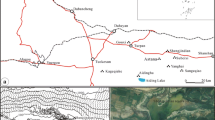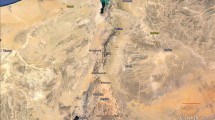Abstract
Archaeobotanical studies were undertaken at the Yuergou site, which is located in the Turpan basin in Xinjiang, China, and which has been dated to around 2300–2400 years b.p. Altogether 21 taxa were identified. Four cereal remains were identified, Triticum aestivum, Hordeum vulgare var. coeleste, Panicum miliaceum and Setaria italica. The first three were probably cultivated while the last one may not have been grown deliberately, but probably grew together with plants of P. miliaceum. A fruit stone of Ziziphus jujuba (Chinese date) was discovered, which showed that this may have been cultivated around the site during that time. Charcoal of Picea sp. was found, from wood which must have been used as fuel by the indigenous people. Fifteen taxa of wild plants were also identified, most of which can be considered as weeds, and which grew near the site. Burs of Xanthium strumarium were discovered. As nearly all of them were broken, the seeds may have been used by the ancient inhabitants. Since most of the cereal remains consisted of chaff, they must represent by-products. Furthermore, grains of Echinochloa crus-galli may also have been exploited as complementary food resources. All the above indicate that both cultivated and wild plants were used for cereals, fuel, or other purposes, and plant resources played important roles in the daily life of the ancient inhabitants of the Yuergou site.







Similar content being viewed by others
References
Alonso N, Junyent E, Lafuente A, López JB (2008) Plant remains, storage and crop processing inside the iron age fort of Els Vilars d’Arbeca (Catalonia, Spain). Veget Hist Archaeobot 17:S149–S158
Anonymous (2005) Materia Medica of China. Volume of Uigur Medicine. Shanghai Science & Technology Press, Shanghai (in Chinese)
Bergman F (1935) Newly discovered graves in the lop-nor desert. Geogr Ann 17:44–61
Bergman F, Sylwan V, Konow S, Ljungh H (1939) Archaeological researches in Sinkiang, especially the Lopnor region. Bokforlags aktiebolaget Thule, Stockholm
Bronk Ramsey C (2005) OxCal progam v 3.10. http://www.rlaha.ox.ac.uk/O/oxcal.php
Cheng J, Yang J, Liu P (1992) Timbers of China. Forestry Publishing House, Beijing (in Chinese)
Committee IAWA (2004) Standard list of microscopic features for softwood identification. IAWA J 25:1–70
De Vartavan C (1990) Contaminated plant-foods from the tomb of Tutankhamun: a new interpretive system. J Archaeol Sci 17:473–494
Dong X, Zheng X (2006) Crops and their wild relatives in China. China Agriculture Press, Beijing (in Chinese)
Fahn A, Werker E, Baas P (1986) Wood anatomy and identification of trees and shrubs from Israel and adjacent regions. The Israel Academy of Sciences and Humanities, Jerusalem
Gong Y, Yang Y, Ferguson DK, Tao D, Li W, Wang C, Lü E, Jiang H (2011) Investigation of ancient noodles, cakes, and millet at the Subeixi Site, Xinjiang, China. J Archaeol Sci 38:470–479
Hald MM, Charles M (2008) Storage of crops during the fourth and third millennia B.C. at the settlement mound of Tell Brak, northeast Syria. Veget Hist Archaeobot 17:S35–S41
Han Y (2005) The pharmaceutical value of Xanthium sibiricum Patr. Pract J Med Pharm 22:262–263 (In Chinese)
Hunt HM, Linden V, Liu X, Motuzaite-Matuzeviciute G, Colledge S, Jones M (2008) Millets across Eurasia: chronology and context of early records of the genera Panicum and Setaria from archaeological sites in the Old World. Veget Hist Archaeobot 17:5–18
Jacomet S (2006) Identification of cereal remains from archaeological sites, 2nd edn. IPAS, Basel University. http://ipna.unibas.ch/archbot/pdf/Cereal_Id_Manual_engl.pdf
Jiang H (2006) The plant remains of the Yanghai tombs (2500 yrs b.p), and their relationship to the ancient Yanghai people and environment. Doctoral thesis. Graduate University of Chinese Academy of Sciences, Beijing, China (in Chinese with English abstract)
Jiang H, Li X, Zhao YX, Ferguson DK, Subir B, Francis H, Wang YF, Zhao LC, Liu CJ, Li CS (2006) A new insight into Cannabis sativa (Cannabaceae) utilization from 2500-year-old Yanghai Tombs, Xinjiang, China. J Ethnopharmacol 108:414–422
Jiang H, Li X, Liu CJ, Wang YF, Li CS (2007a) Fruits of Lithospermum officinale L. (Boraginaceae) used as an early plant decoration (2500 years B.P.) in Xinjiang. China. J Archaeol Sci 34:167–170
Jiang H, Li X, Li C (2007b) Cereal remains from Yanghai Tomb in Turpan, Xinjiang and their palaeoenvironmental significance. J Palaeogeogr 9:551–558 (in Chinese with English abstract)
Jiang H, Zhang YB, Li X, Yao YF, Ferguson DK, Lü EG, Li CS (2009) Evidence for early viticulture in China: proof of a grapevine (Vitis vinifera L., Vitaceae) in the Yanghai Tombs, Xinjiang. J Archaeol Sci 36:1,458–1,465
Li C, Lister DL, Li H, Xu Y, Cui Y, Bower MA, Jones MK, Zhou H (2011) Ancient DNA analysis of desiccated wheat grains excavated from a Bronze age cemetery in Xinjiang. J Archaeol Sci 38:115–119
Lin J, Hu Y (2000) Atlas of structure of Gymnosperms. Science Press, Beijing
List GR, Spencer GF, Hunt WH (1979) Toxic weed seed contaminants in soybean processing. J Am Oil Chem Soc 56:706–710
Liu CJ, Gu HB (2007) Chengtoushan yizhi de zhiwu yicun (Archaeobotanical studies of the Chengtoushan site). In: He JJ, Yasuda Y (eds) Chengtoushan in Lixian. Sino-Japan Cooperative Research on Environmental Archaeology in the Liyang Plain. Cultural Relics Publishing House, Beijing, pp 98–106 (in Chinese)
Lü E, Zheng B (2002) Studies of the Subeixi site and cemeteries in Shanshan Xinjiang. Kaogu (Archaeology) 6:42–57 (in Chinese)
LWA (Luoyang workgroup of antiquities) (2002) Zaojiaoshu in Luoyang. Science Press, Beijing (in Chinese)
Mandelbaum CI, Barbeau WE, Hilu KW (1995) Protein, calcium, and iron content of wild and cultivated species of Echinochloa. Plant Food Hum Nutr 47:101–108
Marinval P (1992) Archaeobotanical data on millets (Panicum miliaceum and Setaria italica) in France. Rev Palaeobot Palynol 73:259–270
Out WA (2010) Firewood collection strategies at Dutch wetland sites in the process of Neolithisation. Holocene 20:191–204
Qu Z, Wang Y (1993) China fruit-plant monograph. China Forestry Press, Beijing (in Chinese)
Reimer PJ, Baillie MGL, Bard E, Bayliss A, Beck JW, Bertrand CJH, Blackwell PG, Buck CE, Burr GS, Cutler KB, Damon PE, Edwards RL, Fairbanks RG, Friedrich M, Guilderson TP, Hogg AG, Hughen KA, Kromer BGM, Manning S, Ramsey CB, Reimer RW, Remmele S, Southon JR, Stuiver M, Talamo S, Taylor FW, Van der Plicht J, Weyhenmeyer CE (2004) IntCal04—terrestrial radiocarbon age calibration, 0–26 cal kyr B.P. Radiocarbon 46:1,029–1,058
Renfrew JM (1973) Palaeoethnobotany. The prehistoric food plants of the Near East and Europe, Methuen
Schweingruber FH (1990) Anatomy of European woods—an atlas for the identification of European trees, shrubs and dwarf shrubs. Haupt, Berne
Sostarić R, Alegro A, Hrsak V, Stancić Z, Küster H (2009) Plant remains from an early Iron Age well at Hajndl, Slovenia. Coll Antropol 33:1,295–1,301
Van der Veen M, Jones G (2006) A re-analysis of agricultural production and consumption: implications for understanding the British Iron Age. Veget Hist Archaeobot 15:217–228
Wang B (1981) Excavation of the wooden-chambered tomb at Alagou in Xinjiang. Wenwu 1:18–22 (in Chinese)
Wang B (1983) Agricultural archaeology in Xinjiang. Nongye Kaogu (Agricultural Archaeology) 1:102–121 (in Chinese)
Wang B (1992) The ancient civilization in Turpan. Xinjiang People’s Publishing House, Urumchi (in Chinese)
Wang B (2009) Archaeological excavations at Gumugou Site, Kongque River and a preliminary study on the discoveries. In: Wang B (ed) Archaeological survey of the ancient Silk Road. Xinjiang People’s Publishing House, Urumchi (in Chinese)
Wang Q, Zhang ZL, Ding H, Shao WB, Li CS, Wang YF, Yang J (2009) The wood in the pits of terracotta figures and its architectural application. J Archaeol Sci 36:555–561
Xia L (1997) Environmental accommodate of the ancient Loulan people: a consideration of the mortuary objects Ephdra of the Lop Nor. Social Sciences in China 3:115–129 (in Chinese)
XIA, BCRTP (Xinjiang Institute Archaeology, Bureau of Cultural Relics of Turpan Prefecture) (2004) New results of archaeological work in Turpan: excavation of the Yanghai Graveyard. Turfanol Res 1:1–66 (in Chinese)
Yan J, Yang J (1999) Systematic biology of the Triticum Tribe, vol 1. Triticum and Aegilops complex, vol 1. China Agricultural Publishing House, Beijing (in Chinese)
Zhao K, Li X, Zhou X, Dodson J, Ji M (2012) Characteristics of agricultural activities and its impact on the environment at Xintala Site, Xinjiang, reconstructed from archaeological plant remains. Quat Sci 32:219–225 (in Chinese with English abstract)
Acknowledgements
We are greatly indebted to the editor and the two anonymous reviewers for their critical revision of an earlier version of this manuscript. We would like to thank Enguo Lü for his help during field work in Turpan. Thanks are also due to Chengzhong Han for his many constructive suggestions. This study was supported by the program of National Natural Science Foundation of China (No. 41102114), as well as the “Strategic Priority Research Program–Climate Change: Carbon Budget and Relevant Issues’’ of the Chinese Academy of Sciences (Grant No. XDA05130501).
Author information
Authors and Affiliations
Corresponding author
Additional information
Communicated by Y. Zhao.
Rights and permissions
About this article
Cite this article
Jiang, H., Wu, Y., Wang, H. et al. Ancient plant use at the site of Yuergou, Xinjiang, China: implications from desiccated and charred plant remains. Veget Hist Archaeobot 22, 129–140 (2013). https://doi.org/10.1007/s00334-012-0365-z
Received:
Accepted:
Published:
Issue Date:
DOI: https://doi.org/10.1007/s00334-012-0365-z




